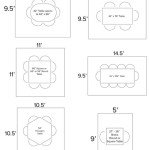How To Build A Brick Circular Patio
Constructing a circular brick patio adds a unique aesthetic to any outdoor space. Unlike rectangular or square patios, a circular design offers a softer, more organic feel. This article provides a comprehensive guide on how to build a brick circular patio, covering everything from initial planning to the final laying of the bricks.
Before beginning any construction project, it's crucial to understand the scope of the work involved. Building a circular patio requires careful planning, accurate measurements, and diligent execution. The success of the project hinges on a solid foundation, precise cuts, and consistent bricklaying techniques.
Planning and Preparation
The initial stage involves planning and preparing the area. This includes determining the desired size and location of the patio, gathering the necessary tools and materials, and preparing the foundational base.
1. Determining Size and Location: The size of the circular patio will be dictated by the available space and intended use. Mark the desired location and use a measuring tape to determine the diameter of the circle. Consider the placement of furniture and traffic flow when deciding on the size. It is also important to consider the existing landscape and how the patio will integrate with it. A larger patio will require more materials and labor, so it's important to balance aesthetics with practicality and budget.
2. Gathering Tools and Materials: A comprehensive list of tools and materials is essential. This will help prevent delays and ensure a smooth construction process. The required tools include a shovel, measuring tape, level, tamper, circular saw with a masonry blade (or a brick hammer and chisel), safety glasses, work gloves, a wheelbarrow, a rake, and a garden hose. Materials include bricks (sufficient quantities based on the patio's area), landscape fabric, gravel, sand, and edge restraints (optional, but recommended).
3. Preparing the Base: Proper base preparation is critical for the longevity and stability of the patio. Start by removing any existing grass, soil, or debris from the designated area. Excavate the area to a depth of approximately 6-8 inches. The depth will depend on the type of soil and the expected load the patio will bear. Ensure the bottom of the excavation is level using a level and adjust as needed. This leveled surface will serve as the foundation for the subsequent layers.
4. Laying the Foundation Layers: Begin by laying down a layer of landscape fabric. This fabric helps prevent weed growth and stabilizes the base. Over the landscape fabric, spread a 4-inch layer of gravel. Use a rake to distribute the gravel evenly. Compact the gravel layer using a tamper. Compacting the gravel ensures a solid foundation and prevents settling. After the gravel is compacted, spread a 2-inch layer of sand over the gravel. Rake the sand to create a smooth, even surface. This sand layer will provide a level bed for the bricks.
Laying the Bricks
The core of the project involves laying the bricks in a circular pattern. This requires careful measurement, precise cutting, and consistent spacing. The laying process is critical for the aesthetic appeal and structural integrity of the patio.
1. Establishing the Center Point: Drive a stake into the center of the excavated area. This stake will serve as the pivot point for creating the circular pattern. Attach a string to the stake, with the length of the string equal to the desired radius of the patio. Use this string as a guide to mark the outer edge of the circle in the sand. This will help maintain a consistent circular shape throughout the bricklaying process.
2. Laying the First Course: Start laying the first course of bricks along the marked circle. Use a level to ensure each brick is level with the surrounding bricks. Adjust the sand beneath each brick as needed to achieve a level surface. The first course of bricks is critical for establishing the shape and size of the patio. Take your time and ensure the bricks are laid accurately.
3. Cutting Bricks for Circular Pattern: Laying bricks in a circle requires cutting some bricks to fit the curved edges. This is where a circular saw with a masonry blade or a brick hammer and chisel is used. Measure the spaces between the bricks and mark the cut lines on the bricks. Use the circular saw or hammer and chisel to cut the bricks along the marked lines. Wear safety glasses and work gloves when cutting bricks to protect your eyes and hands from flying debris. Ensure the cut bricks fit snugly into the spaces, maintaining a consistent spacing between the bricks.
4. Continuing the Pattern: Continue laying the bricks in concentric circles, working from the outer edge towards the center. Maintain a consistent spacing between the bricks. Use a level to ensure each brick is level with the surrounding bricks. Cut the bricks as needed to fit the circular pattern. As you work towards the center, the cuts will become more frequent and precise. Take your time and ensure the bricks are laid accurately to create a visually appealing and structurally sound patio.
5. Filling Gaps and Joints: Once all the bricks are laid, fill the gaps and joints between the bricks with sand. Sweep the sand across the patio surface, ensuring the sand fills all the gaps and joints. Use a brush to remove any excess sand from the brick surface. The sand helps lock the bricks in place and prevents weed growth. Repeat the process of sweeping sand into the gaps and joints as needed until they are completely filled.
Finishing Touches and Maintenance
Completing the patio involves adding finishing touches, such as edge restraints, and implementing a maintenance plan to ensure the patio's longevity. Edge restraints prevent the bricks from shifting and help maintain the patio's shape. Regular maintenance will keep the patio looking its best and prevent damage.
1. Installing Edge Restraints (Optional): Edge restraints are not mandatory but highly recommended. They provide additional support and prevent the bricks from shifting over time. Install the edge restraints around the perimeter of the patio, following the manufacturer's instructions. Secure the edge restraints to the ground using stakes or screws. Edge restraints are particularly important in areas with heavy foot traffic or where the ground is prone to shifting.
2. Compacting the Surface: Use a plate compactor to compact the entire patio surface. This will help settle the bricks and lock the joints. Compacting the surface also helps to create a level and even surface. Ensure the plate compactor is suitable for use on brick surfaces to avoid damaging the bricks.
3. Sealing the Bricks (Optional): Sealing the bricks helps protect them from stains, water damage, and fading. Choose a sealer that is specifically designed for use on brick surfaces. Apply the sealer according to the manufacturer's instructions. Sealing the bricks can extend the life of the patio and keep it looking its best for years to come.
4. Ongoing Maintenance: Regular maintenance is essential for keeping the brick patio in good condition. Sweep the patio regularly to remove dirt and debris. Wash the patio with a mild soap and water solution as needed to remove stains. Reapply sand to the gaps and joints as needed to prevent weed growth. Inspect the patio regularly for any signs of damage, such as cracked or shifting bricks, and repair them promptly. With proper maintenance, a brick circular patio can provide years of enjoyment and enhance the beauty of any outdoor space.
Building a circular brick patio is a rewarding project that can add significant value and beauty to a home. By following these detailed steps, even novice DIYers can create a stunning and durable outdoor living space. The key is to prioritize careful planning, accurate measurements, and meticulous execution. The result will be a beautiful and functional patio that will be enjoyed for years to come.

Inside Out How A Nationally Known Interior Stylist And Her Dedicated Diy Er Husband Took It Outside To Add Circular Patio In Their Backyard Pine Hall Brick

How To Build A Round Paver Patio

How To Lay A Circular Patio Hardscape Basics Western Interlock

Backyard Beauty Create Your Own Brick Patio With This Diy Patios Rustic Pavers

Think Outside The Square Curved And Round Patios Walkways Pine Hall Brick

Circular Patio Kit How To Menards

Backyard Makeover How To Build A Brick Patio Circle Patios Patterns

How To Design And Build A Stone Or Brick Patio

Creative Endeavors Brick Patio Tutorial

Circular Bricks Designs For Gardens
Related Posts








